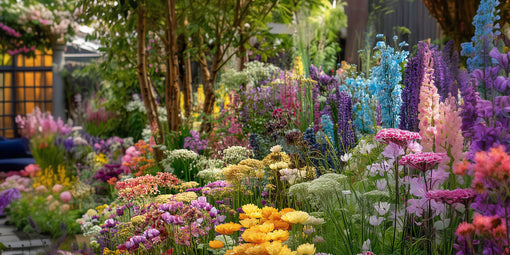
- Article published at:
Drawer menu

Welcome to the enchanting world of larkspur flowers! These captivating blooms have been cherished for centuries for their beauty and elegance. Whether you're an avid gardener or someone who appreciates the delicate charm of flowers, larkspurs offer something truly special.
In this blog post, we'll explore everything you need to know about larkspur flowers, from their basic characteristics and growing tips to their cultural significance and uses in floral arrangements. Let's dive in and discover the magic of larkspur!
Larkspur flowers, known for their tall, graceful spikes, come in a variety of colours including blue, purple, pink, and white. These blooms are part of the genus Delphinium and are characterised by their spurred petals that resemble the shape of a dolphin, which is where they get their name. With their vibrant hues and intricate shapes, larkspurs add a touch of elegance to any garden or bouquet.
Larkspur and delphinium are often confused due to their similar appearance, but they have distinct differences. Larkspur generally refers to annual species within the genus Consolida, while delphinium includes perennial species in the Delphinium genus.
Larkspurs tend to have a more delicate, airy structure with thinner stems and smaller blooms, making them ideal for naturalistic gardens and wildflower arrangements. In contrast, delphiniums are known for their robust, tall spikes of densely packed flowers, which make a dramatic statement in perennial borders.
Additionally, larkspurs are usually easier to grow and are less demanding in terms of soil and climate conditions compared to the often more temperamental delphiniums, which require rich, well-drained soil and cooler climates to thrive.
Scientifically known as Delphinium, larkspurs belong to the Ranunculaceae family. They are native to the Northern Hemisphere and are commonly found in meadows and woodlands. There are over 300 species of larkspur, each with its unique features and growing conditions.

Larkspurs thrive in well-drained soil and prefer a sunny location. They can tolerate partial shade, but for the best blooms, full sunlight is recommended. These flowers prefer cooler climates and do well in areas with mild summers.
To grow larkspurs, start by planting seeds in early spring or fall. Sow the seeds directly into the garden soil, about 1/8 inch deep. Keep the soil moist but not waterlogged. Once the seedlings emerge, thin them to ensure proper spacing. Regular watering and occasional fertilizing will help your larkspurs flourish.
Larkspurs can be susceptible to pests like aphids and diseases such as powdery mildew. To prevent these issues, ensure good air circulation around the plants and avoid overhead watering. If problems arise, organic insecticidal soap and fungicides can be effective treatments.

Larkspurs have a rich history and have been used in various cultures for centuries. In ancient times, they were believed to ward off scorpions and other pests. In folklore, larkspurs were thought to bring protection and were often used in rituals and ceremonies.
Today, larkspurs symbolise a range of meanings, from love and affection to lightness and levity. They are often used in floral arrangements for weddings and other special occasions, representing positivity and an open heart.

Larkspurs are incredibly versatile and can be used in a variety of floral arrangements. Their tall, slender spikes make them perfect for adding height and drama to bouquets and centerpieces. They pair beautifully with roses, lilies, and other garden favorites.
Creating your own larkspur bouquet is simple and rewarding. Start with a tall vase and arrange the larkspurs in the center, adding other flowers around them. Trim the stems at an angle and change the water regularly to keep the arrangement fresh. Enjoy the vibrant colours and delicate fragrance of your homemade bouquet!
Tall Larkspur (Delphinium elatum): Known for its impressive height and large, colourful blooms.
Rocket Larkspur (Delphinium ajacis): A favorite for its bright colours and more compact growth.

Larkspurs have unique characteristics, such as their spurred petals that look like a dolphin. Historically, they were used to make blue dye and as a natural insect repellent. These flowers also have a storied past in various cultures, often associated with protection and good fortune.
Larkspurs have inspired many artists and writers. They appear in paintings by famous artists and are mentioned in classic literature, symbolising beauty, joy, and the ephemeral nature of life.
In this journey through the world of larkspur flowers, we've explored their stunning beauty, unique characteristics, and rich cultural significance. From growing tips to creative uses in floral arrangements, larkspurs offer endless possibilities for gardeners and flower enthusiasts alike. So why not consider adding these charming blooms to your garden or include in your next bouquet order? Let the delicate beauty of larkspurs brighten your days and bring a touch of elegance to any occasion.
IX. Additional Resources
Ready to bring some larkspur magic into your life? Give these stunning flowers a try in your garden or floral arrangements. Share your larkspur stories and photos in the comments below – we can't wait to see how you incorporate these beautiful blooms into your world!